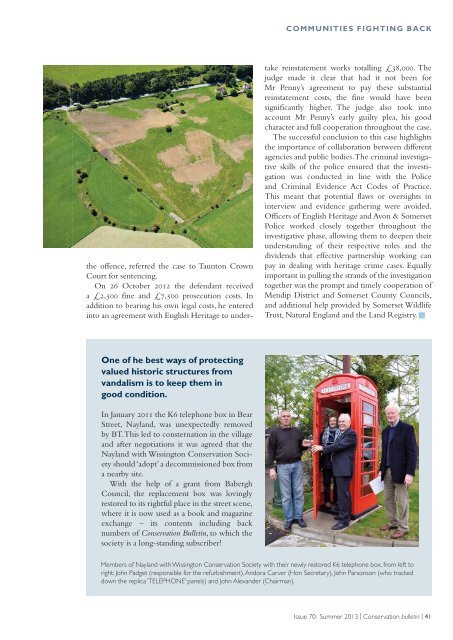Conservation Bulletin 70 | PDF - English Heritage
Conservation Bulletin 70 | PDF - English Heritage
Conservation Bulletin 70 | PDF - English Heritage
Create successful ePaper yourself
Turn your PDF publications into a flip-book with our unique Google optimized e-Paper software.
COMMUNITIES FIGHTING BACK<br />
the offence, referred the case to Taunton Crown<br />
Court for sentencing.<br />
On 26 October 2012 the defendant received<br />
a £2,500 fine and £7,500 prosecution costs. In<br />
addition to bearing his own legal costs, he entered<br />
into an agreement with <strong>English</strong> <strong>Heritage</strong> to undertake<br />
reinstatement works totalling £38,000. The<br />
judge made it clear that had it not been for<br />
Mr Penny’s agreement to pay these substantial<br />
reinstatement costs, the fine would have been<br />
significantly higher. The judge also took into<br />
account Mr Penny’s early guilty plea, his good<br />
character and full cooperation throughout the case.<br />
The successful conclusion to this case highlights<br />
the importance of collaboration between different<br />
agencies and public bodies.The criminal investigative<br />
skills of the police ensured that the investigation<br />
was conducted in line with the Police<br />
and Criminal Evidence Act Codes of Practice.<br />
This meant that potential flaws or oversights in<br />
interview and evidence gathering were avoided.<br />
Officers of <strong>English</strong> <strong>Heritage</strong> and Avon & Somerset<br />
Police worked closely together throughout the<br />
investigative phase, allowing them to deepen their<br />
understanding of their respective roles and the<br />
dividends that effective partnership working can<br />
pay in dealing with heritage crime cases. Equally<br />
important in pulling the strands of the investigation<br />
together was the prompt and timely cooperation of<br />
Mendip District and Somerset County Councils,<br />
and additional help provided by Somerset Wildlife<br />
Trust, Natural England and the Land Registry. ■<br />
One of he best ways of protecting<br />
valued historic structures from<br />
vandalism is to keep them in<br />
good condition.<br />
In January 2011 the K6 telephone box in Bear<br />
Street, Nayland, was unexpectedly removed<br />
by BT.This led to consternation in the village<br />
and after negotiations it was agreed that the<br />
Nayland with Wissington <strong>Conservation</strong> Society<br />
should ‘adopt’ a decommissioned box from<br />
a nearby site.<br />
With the help of a grant from Babergh<br />
Council, the replacement box was lovingly<br />
restored to its rightful place in the street scene,<br />
where it is now used as a book and magazine<br />
exchange – its contents including back<br />
numbers of <strong>Conservation</strong> <strong>Bulletin</strong>, to which the<br />
society is a long-standing subscriber!<br />
Members of Nayland with Wissington <strong>Conservation</strong> Society with their newly restored K6 telephone box, from left to<br />
right: John Padget (responsible for the refurbishment),Andora Carver (Hon Secretary), John Parsonson (who tracked<br />
down the replica ‘TELEPHONE’ panels) and John Alexander (Chairman).<br />
Issue <strong>70</strong>: Summer 2013 | <strong>Conservation</strong> bulletin | 41

















